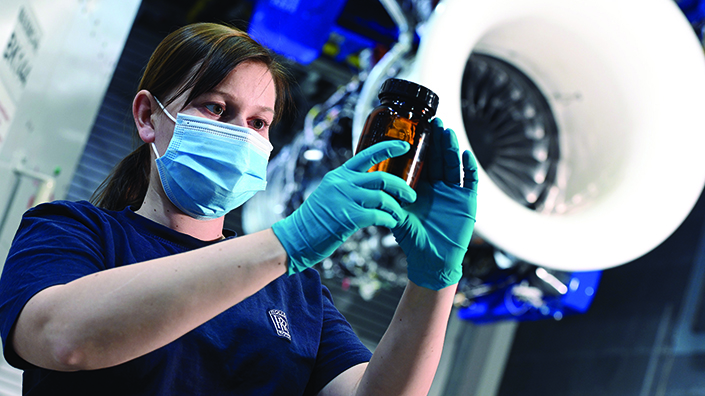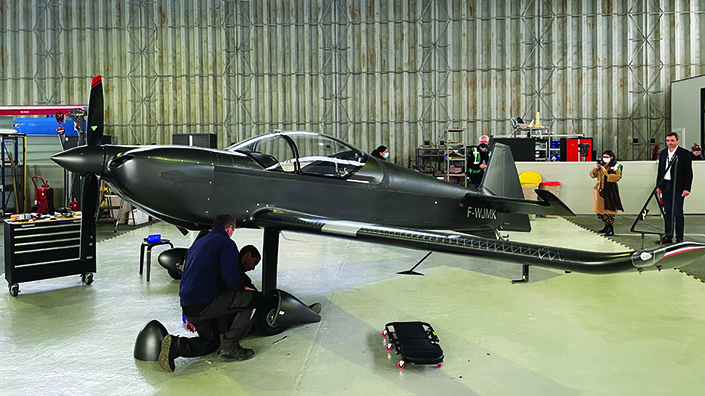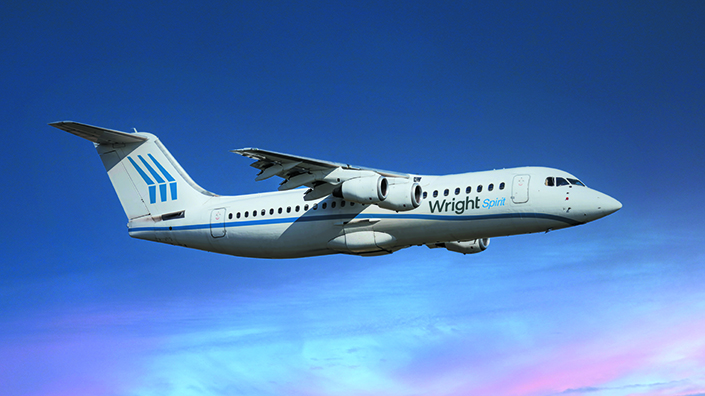Then the pandemic hit aviation hard. An industry that had been consistently growing at breakneck speed stopped abruptly. Aircraft and contrails disappeared from the skies, while plants such as the Airbus factory in Toulouse, France, and Boeing’s Everett factory in Washington state, shut down.
While the skies were empty and the factories silent, environmental considerations rose up the agenda. One of Covid-19’s most significant legacies in aerospace looks set to be a greater shift towards sustainability.
The International Energy Agency predicts that emissions from aviation could triple within three decades if nothing is done to address the problem. Furthermore, efforts to reduce emissions through refining aircraft designs and new technology were being swallowed up by the sector’s incessant growth pre-pandemic.
Aviation knows it must clean up its act and try harder to safeguard its future. Speaking at a recent Royal Aeronautical Society conference in London called Cutting Aviation’s Climate Change Impact, industry analyst Robert Thomson, managing partner at consultants Roland Berger, said: “There is no single, simple solution to reduce aviation’s impact on the environment. It will include the use of hybrids, fully electric, hydrogen, sustainable aviation fuel, combined with the use of more efficient engines and improved aircraft designs.
“But for the next 10 to fifteen years sustainable fuels are the only way forward for the industry.”
Sustainable aviation fuels (SAF) are produced from sustainable sources such as waste oils, agricultural residues or non-fossil-fuel derived CO2. They can be swapped for jet fuel at various ratios without modifying engines, although aircraft are currently only certified to operate on a maximum blend of 50%. SAF can reduce CO2 emissions by up to 80% compared to conventional jet fuel, says air travel industry association IATA.
Airliners are being tested to run on 100% SAF. Airbus flew the A319neo on 100% SAF for the first time last November. Rolls-Royce has committed to ensuring that its Trent engine range can run on 100% SAF by 2023, and the company conducted its first test flight with a Trent 1000 engine last October.
In 2016 there were 500 flights that used SAF, and by 2025 analysts believe there will be around one million. Jonathon Counsell, head of sustainability at International Airlines Group, says: “We are on the cusp of seeing SAF take-off.
“SAF is the only realistic solution for medium and long-haul flights. We are beginning to see international convergence on the targets – 10% by 2030 and at least 60% of flights by 2050 using SAF.”

Rolls-Royce flight tested a 100% blend of SAF using its Boeing 737 testbed. For the first time Rolls-Royce has tested 100% sustainable aviation fuel on its latest business aviation engine, the Pearl 700
FlyZero
Meanwhile, engineers are taking more radical steps in propulsion systems and aircraft design by considering alternative fuels such as hydrogen.
FlyZero is a research project within the UK’s Aerospace Technology Institute that is investigating how to develop a zero-carbon-emissions aircraft by the end of this decade. Since launching in 2020, 13 companies and 100 people have joined the project. The initiative will develop three commercial aircraft concepts in the regional and sub-regional categories with 50 seats, and a single-aisle mid-size aircraft with between 200 and 250 seats. It will include cost-benefit analyses, technology roadmaps and capability assessments.
Chris Gear, FlyZero project director, says: “Twenty per cent of an aircraft’s take-off weight is fuel. Hydrogen’s energy content is three times that of kerosene, six times that of ammonia and up to 60 times that of batteries. This is why people see liquid hydrogen as a potential solution to reduce aircraft carbon emissions.”
Hydrogen can be used by fuel cells to produce electricity on board aircraft, or combusted directly in jet engines. Gear believes areas where aerospace engineers face the greatest challenge integrating hydrogen storage and propulsion systems include thermal management and cryogenics. “We are playing with the volume of the tanks and the weight of the equipment it carries in our analysis and I’m not seeing a reduction in aircraft range and speed, but we are looking at those parameters,” he says.
“This is more of a revolution than an evolution in technology. For areas like delivering cryogenics there is limited capability. We need to deliver training here at school level.”
New designs
The Airbus Zero E project to develop hydrogen aircraft prototypes started in 2018. The programme aims to demonstrate the technologies, including the propulsion system, in flight separately before converging them into a single aircraft by 2025, with entry into service by 2035.
Glenn Llewellyn, vice-president of zero-emission aircraft at Airbus, says: “Now is the time to start the acceleration towards products that meet the societal and regulatory requirements of the future.
“We want to use synthetic fuels from direct air carbon capture and low-carbon power sources. We see this source as very sustainable in the future. We do also see potential in hydrogen in its raw form and that is the focus of Zero E.
“Hydrogen has huge potential in aviation, but at the start of the project we were missing the pull from other sectors to help create a global infrastructure. Now there are many more companies introducing hydrogen-fuelled trucks, trains, buses and ferries.
“This will result in a massive scale-up of hydrogen infrastructure, reducing the challenge for the aerospace sector.”
According to Llewellyn, Zero E is aiming not just to develop an aircraft that is technically feasible, but also one that will be commercially viable. This means the project is measuring itself against CO2 emissions saved, resulting in some designs coming out as more suitable when assessed.
“A blended wing has more internal volume and hydrogen needs storage space,” says Llewellyn. “So it’s more likely a blended wing will be successful in the future. However, 2035’s aircraft will be more like a classic tube-and-wing design, with a longer rear fuselage for hydrogen storage.” Llewellyn adds that the basic feasibility of hydrogen propulsion and storage technology has already been demonstrated, so the job for engineers is to integrate it into an aircraft suitable for use in commercial aviation.
Aerospace Valley
In Aerospace Valley in the Occitanie and Nouvelle-Aquitaine regions of southern France, it is not just Airbus that has taken up the cause of sustainable aviation, but also a myriad of suppliers and smaller firms.
Aerospace Valley comprises more than 800 companies involved in aerospace that employ 146,000 people. Within the valley, the MAELE (Light and Environmentally Responsible Air Mobility) research initiative was launched in 2020 to bring together companies interested in developing carbon-free aircraft.
Bruno Darboux, vice-president of aerospace ecosystem development at Airbus and president of Aerospace Valley, says: “With the technologies available, the easiest gains can be made flying and testing smaller, lighter aircraft. So we are trying to animate the general aviation market first. That will help to bring the larger commercial passenger market forward faster.”

Aura Aero’s Integral test aircraft, which is 70% wooden
Flight testing
MAELE has more than 200 organisations and 480 people involved. It is funding 14 projects involving 30 companies, working on aspects of more sustainable aviation such as flight-testing fuel cells and hybrid-electric powertrains.
“We are not fully equipped with all the test rigs and facilities we need to work with hydrogen and electric yet,” says Darboux. “One of the projects is setting up a hydrogen test platform. For electricity it is mixed. Larger companies like Airbus and Safran have their own equipment.”
One of the foremost examples of Aerospace Valley’s trend towards sustainable aviation is Aura Aero. Housed in hangar HM7 on the Francazal airfield to the south of Toulouse, the company is developing a range of aircraft including the Integral two-seater general aviation training aircraft and the ERA (Electric Regional Aircraft) 19-seat regional airliner.
Founded in 2018, Aura Aero’s approach to sustainability extends in a unique way to the aircraft’s materials. Around 70% of the Integral is made of aerospace-grade reinforced wood. The rest – including the rudder, elevator and aileron – is made from composites.
Although the use of wood evokes a bygone age of aviation, complete with biplanes and open cockpits, there are several benefits. For light aircraft, wood is good for performance and adds density and strength.
Jérémy Caussade, president of Aura Aero, says: “You can manufacture a wood structure without a huge investment in tooling. Wood is a natural composite so you can work with it using cold manufacturing techniques.
“We are assessing which parts it is appropriate to manufacture at a low scale and at a high scale in wood and composites. But wood is very repairable and is naturally sustainable – the aircraft has a low carbon footprint and high recyclability.
“We think the aerospace sector will see more hybridisation of materials in the future – we have a carbon workshop and a wood workshop for production.”
The company is scaling up the manufacturing, design and testing processes for the Integral and going through the process of gaining certification for its first aircraft, the Integral R, which uses a conventional Lycoming engine. Next year engineers at Aura plan to swap the Lycoming for an electric powertrain and start flying the Integral E. With the bulk of testing and certification having been carried out on the Intergral R, the wooden/composite version is expected to enter service in 2023.
Designed for flexibility
Wilfried Dufaud, co-founder, general manager and chief product officer at Aura Aero, says: “The aircraft was designed to be flexible and to integrate with different power systems. Next year the focus will be on the power, but it is less work than the whole certification process for the aircraft.”
Aura Aero expects to produce between 30 and 50 Integral aircraft a year at first, while progressing development of the ERA electric regional aircraft. ERA, which will have a 300-mile range, will not be made of wood and will be manufactured in a different location. The aircraft was revealed last March and will use Safran’s ENGINeUS motors.
“ERA will be based on the same hybrid technological bricks we are developing for the Integral family and use the same skills, particularly around electrical, hybridisation and digital design and manufacturing,” says Dufaud.
While the scale of the challenge to reduce aviation’s impact on climate change is massive, action to clean up the sector’s emissions has a renewed impetus post-pandemic. Sustainable fuels will help cut the emissions of current fleets, while we will see the first cleaner and zero-emission passenger aircraft in the form of regional aircraft this decade. These will lay the groundwork for the first zero-emission larger commercial passenger aircraft by the middle of the 2030s and beyond.
Zero-emission regional aircraft to take off

Wright Electric plans to modify and operate BAe 146 aircraft with its electric propulsion system
Aircraft manufacturers in Europe are modifying existing fleets of regional aircraft to be powered by batteries and hydrogen.
Two-seater electric trainer aircraft such as Pipistrel’s Velis Electro are already available. But the limitations of battery technology, the complexity of integrating hydrogen fuel systems and high costs mean that the next zero-emission aircraft to fly will be older regional aeroplanes, modified to be powered by batteries or hydrogen fuel cells.
Leading companies include UK-US firm ZeroAvia, which in 2020 flew a full-size test aircraft powered by a hydrogen fuel cell. Last October ZeroAvia launched a partnership with Alaska Airlines to integrate a hydrogen-electric powertrain into the US company’s De Havilland regional jets.
Last November, US-based Wright Electric announced plans to fit the 2MW electric propulsion system it is developing onto a fleet of BAe 146 regional aircraft and fly them in fully-electric mode within the next three years. The BAe 146 was produced in the 1980s.
Meanwhile in Germany, Deutsche Aircraft is updating the 1990s Dornier 328 regional aircraft, first with a sustainable version called the D328eco and then with a hydrogen fuel-cell version by 2025.
Want the best engineering stories delivered straight to your inbox? The Professional Engineering newsletter gives you vital updates on the most cutting-edge engineering and exciting new job opportunities. To sign up, click here.
Content published by Professional Engineering does not necessarily represent the views of the Institution of Mechanical Engineers.